Hair balls: a sonographic challenge
On Friday I saw a pup with a PDA, another slightly older dog with a right gastric-t0-cava portosystemic shunt and a cat with a hairball. Of these, the hairball was the least glamorous but considerably the most challenging.
The patient was a 9-year-old Maine Coon with a 6 month history of progressive weight loss and occasional vomiting, culminating in a week of almost complete anorexia. Physical examination, routine haematology and biochemistry all proved unremarkable.
On sonography the thorax proved unremarkable and the abdomen similarly so…..except that the appearance of the stomach was suspiciously inconsistent with the history of anorexia:
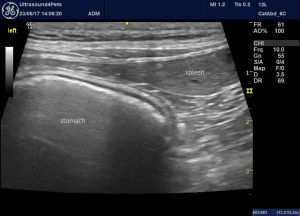
It’s just too full -in the circumstances. It would be easy, I think, to overlook this as just another stomach full of miscellaneous gas/ingesta. There are no irregular ‘corners’ to hint at it being a foreign body. However, there are hints that this echogenic material filling the stomach isn’t just free gas:
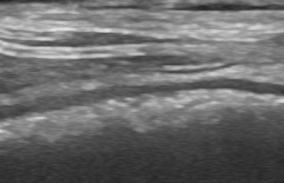
Detail of the margin of stomach content. This echogenic material is creating a ‘shadow’ which obscures everything beyond it. But it’s echotexture at the interface with the mucosa is inhomogeneous with coarse stippling.
Here’s a normal stomach with gas in the fundus for comparison:
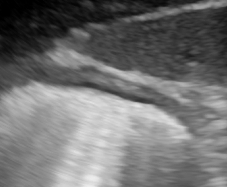
Free gas in the gastric fundus of a dog with no gastrointestinal issues. The interface with the gastric mucosa is sharp. A homogeneously echogenic surface gives way to classic ‘dirty shadowing’ beyond and some comet-tail artefacts.
Secondly, with a bit of hunting around it’s possible to find some areas in our hairball cat where the echogenic margin deviates away from the stomach wall with a little free fluid in between.
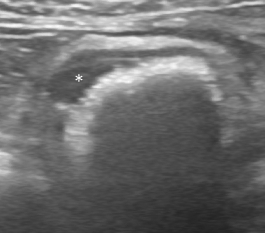
transverse view of the pyloric antrum. The curved echogenic surface deviates from the gastric mucosa with some free fluid in between (asterisk). This is the crucial finding which distinguishes solid ‘objects’ from free gas. Free gas should never consistently have a curved or irregular surface contour unless it is in direct contact with the wall.
Anyway, on the basis of this appearance we took this cat to surgery and extracted a large trichobezoar.
Another hairball GI obstruction:
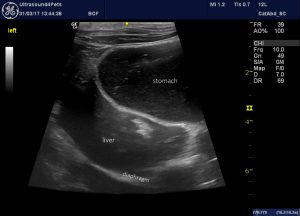
Longitudinal plane view of the cranial abdomen of a cat with 2 days duration vomiting, abdominal pain and anorexia. The stomach is enormously dilated with fluid content -always suspicious for mechanical GI obstruction or functional ileus.
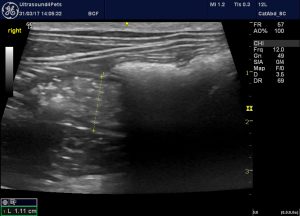
The duodenum is unusually persistently dilated with liquid/ingesta (which would normally transit this part of the gut rapidly). In this cat the descending duodenum runs deep to the caecum which is unhelpfully casting a shadow across the important part.
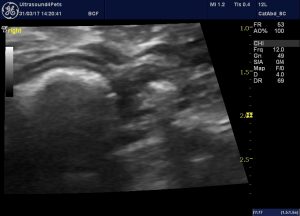
A little further caudal the duodenal lumen is filled by echogenic material. To the right, downstream, the lumen is empty. As with the headline case above the material filling the gut has a mottled echotexture which suggests that it’s not just free gas. The fact that the duodenal lumen was consistently dilated upstream and empty downstream was enough to justify exploratory laparotomy.
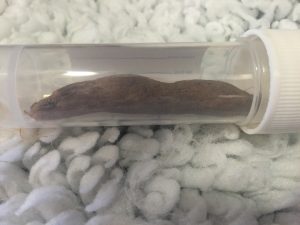
The duodenal hairball or hair-slug






A vet wants to do surgery on my cat that he said a ultra sound is showing a hairball. I don’t know what to do.
He eats, drinks and plays occasionally. He is around 15 years old. I have given him PetroMalt for a month now and some comes out in his stool.
His main symptom is throwing up water. He will want to drink a lot of water and then throws it come. Sometimes this happens daily or three days can go by. One suggested a enema but the cat goes to the bathroom already and sometimes the stool is very soft with fur in it. Please help me. I can’t keep affording the vet bills.
His blood work is almost perfect and his ultra sound showed that his organs are good.
I’d love to be able to help Jeanette: but it just wouldn’t be safe to speculate on what’s causing your cat’s vomiting problem without having a full picture and being able to physically examine him. Like I say in the post, hairballs can be really hard to diagnose with certainty and there are lots of conditions which can cause vomiting in cats. A combination of blood tests and ultrasound is usually the best bet. Ask your vet if he’s sure that the pancreas, stomach wall and small intestine are all unremarkable. It may be your vet is fantastic with ultrasound but there can a big difference between a scan performed by a vet with qualifications/experience and one performed by a general practitioner.